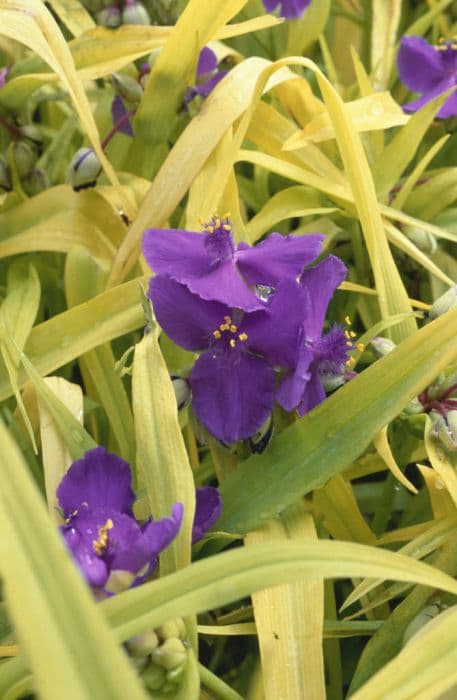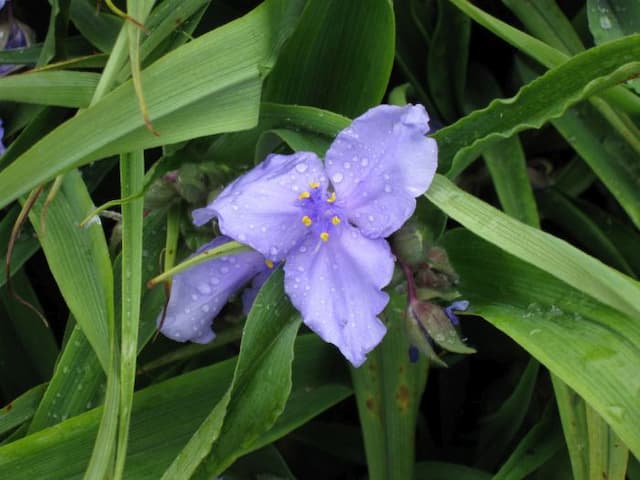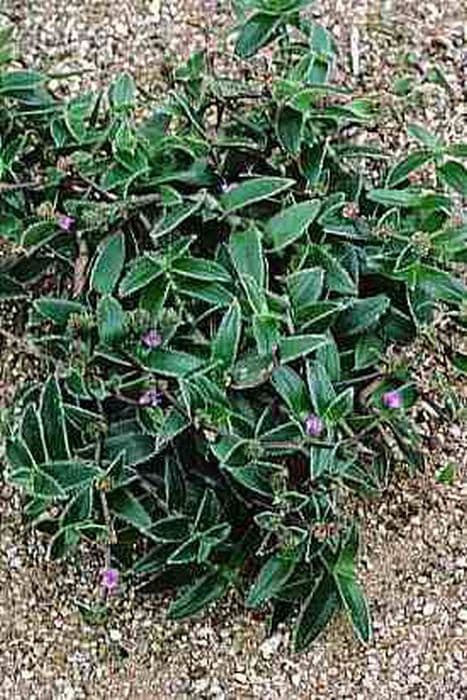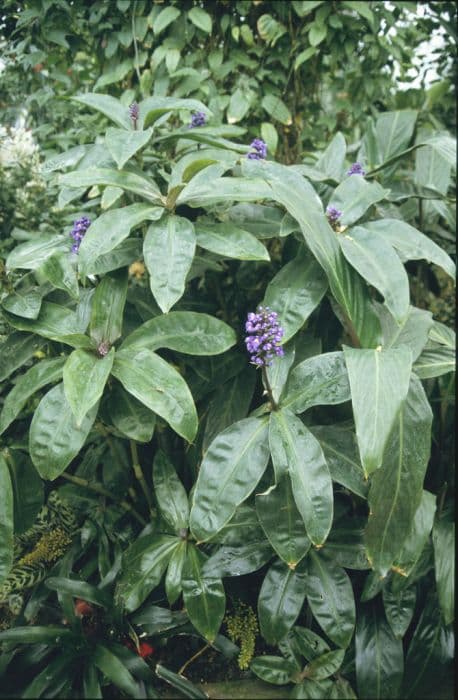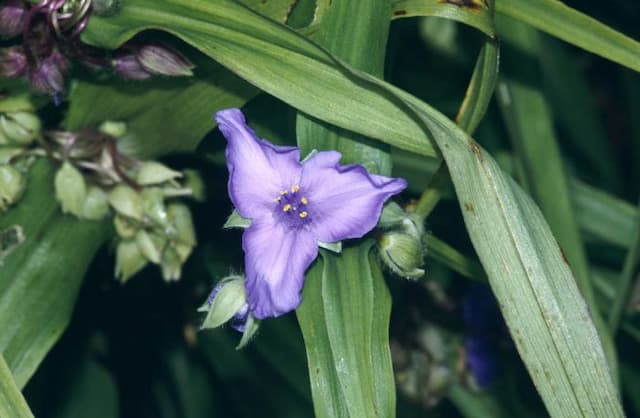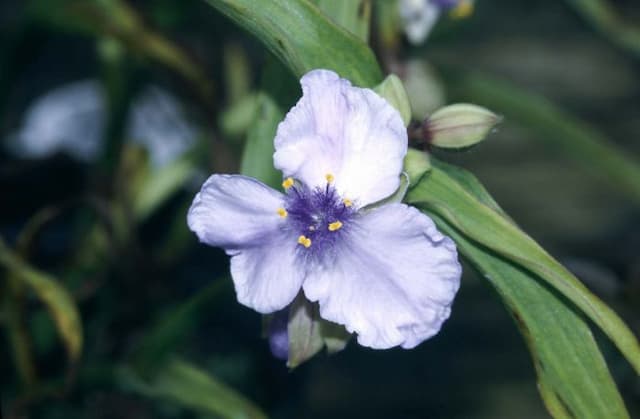Spiderwort Tradescantia (Andersoniana Group) 'Concord Grape'

ABOUT
The plant known as Concord Grape features a striking combination of colors and textures that make it stand out in the garden. The foliage consists of lance-shaped leaves with a lush green color tinged with purple undertones, giving it a rich, velvety appearance. During the blooming season, the plant produces clusters of vibrant, deep-purple flowers, resembling small, three-petaled trumpets that attract viewers with their bold hue and shape. The allure of Concord Grape is further enhanced by the contrast between the darkness of the flowers and the lighter foliage. The stems of the plant are sturdy and may have a hint of purple complementing the overall color scheme. Upon closer inspection, the petals reveal subtle striations of color that catch the light and add depth to their appearance. This plant creates a dense mat of growth and works well as a ground cover, with its foliage and flowers spilling out attractively. The textures of Concord Grape are varied, with the soft, slightly fuzzy leaves providing a tactile experience, while the flowers, when in bloom, create a soft and inviting visual effect. This captivating plant is a crowd-pleaser in any garden due to its striking colors and delightful floral display.
About this plant
 Names
NamesFamily
Commelinaceae
Synonyms
Spiderwort, Widow's Tears
Common names
Tradescantia 'Concord Grape'
 Toxicity
ToxicityTo humans
Tradescantia, commonly known as Spiderwort, is not considered highly toxic to humans. However, if ingested, it can potentially cause mild irritation to the mouth, stomach, or skin in sensitive individuals. The consequences of ingesting parts of the plant are typically not severe, but it's always advisable to avoid eating ornamental plants due to the risk of unexpected allergic reactions or gastrointestinal discomfort.
To pets
Spiderwort is generally considered non-toxic to pets such as cats and dogs. However, ingestion can sometimes cause mild digestive upset, such as vomiting or diarrhea, particularly if the pet eats a significant amount of the plant. If you suspect your pet has eaten a large quantity of Spiderwort and is showing symptoms of discomfort, it's best to consult with a veterinarian.
 Characteristics
CharacteristicsLife cycle
Perennials
Foliage type
Deciduous
Color of leaves
Mixed
Flower color
Purple
Height
1-2 feet (30-60 cm)
Spread
1-2 feet (30-60 cm)
Plant type
Herb
Hardiness zones
4-9
Native area
North America
Benefits
 General Benefits
General Benefits- Aesthetic Appeal - Vibrant purple flowers add visual interest to gardens and landscapes.
- Ease of Care - Requires minimal maintenance, making it suitable for beginner gardeners.
- Drought Tolerance - Once established, it can survive with limited watering, conserving water resources.
- Propagation - Easily propagated through stem cuttings, enabling gardeners to expand their collection without additional cost.
- Rapid Growth - Grows quickly, providing fast coverage for bare spots in the garden.
- Pollinator-Friendly - Attracts bees and butterflies, which are essential for pollination in the garden ecosystem.
- Seasonal Interest - Blooms from late spring to autumn, offering prolonged periods of flowers throughout growing seasons.
- Versatility - Can be grown in borders, containers, and as ground cover, adapting well to various garden designs.
- Winter Hardiness - Capable of surviving in cooler climates, with some varieties being hardy in USDA zones 4-9.
 Medical Properties
Medical PropertiesThis plant is not used for medical purposes.
 Air-purifying Qualities
Air-purifying QualitiesThis plant is not specifically known for air purifying qualities.
 Other Uses
Other Uses- Photography Backdrops: The vibrant purple blooms of the Spiderwort can be used as a natural backdrop for macro and garden photography, enhancing the aesthetic appeal of the photos.
- Educational Tool: Spiderwort can be used in classrooms to teach children about plant biology and the process of pollination due to its easily observable flower parts.
- Artistic Inspiration: Artists can utilize the distinctive color and form of Spiderwort as a subject for paintings, sketches, and fabric designs.
- Indicator Plant: Spiderwort can serve as an indicator species for gardeners, as its sensitivity to changes in the environment can signify soil health or the presence of certain contaminants.
- Ground Cover: Spiderwort is useful for garden ground cover, as it spreads easily and can create a dense mat that suppresses weeds.
- Livestock Forage: In some rural areas, Spiderwort may be used as supplemental forage for livestock, although this is not its primary use.
- Culinary Garnish: The flowers of Spiderwort can be used as an edible garnish for salads and desserts, offering a pop of color and mild flavor.
- Beekeeping Aid: Planting Spiderwort near beehives can assist in beekeeping by providing bees with a source of nectar early in the season.
- Craft Projects: Dried Spiderwort flowers can be incorporated into craft projects such as pressed flower art or natural potpourri mixtures.
- Fish Pond Complement: Spiderwort can be planted around the edges of fish ponds to enhance the natural beauty and provide shade for aquatic life.
Interesting Facts
 Feng Shui
Feng ShuiThe Spiderwort is not used in Feng Shui practice.
 Zodiac Sign Compitability
Zodiac Sign CompitabilityThe Spiderwort is not used in astrology practice.
 Plant Symbolism
Plant Symbolism- Transformation and Change: Tradescantia, commonly known as Spiderwort, often symbolizes change due to its ability to adapt and thrive in various conditions, reflecting life's constant flux.
- Resilience and Survival: With its hardy nature, Spiderwort embodies resilience, representing the ability to endure and overcome difficult circumstances.
- Spirituality and Mysticism: The rich purple color of the 'Concord Grape' variety of Spiderwort is sometimes associated with spirituality and mysticism, suggesting a connection to the unseen and the mysterious.
- Transience of Life: Spiderwort flowers are known for their short bloom time where each blossom lasts for only a day, symbolizing the fleeting nature of life.
 Water
WaterSpiderwort 'Concord Grape' prefers consistent moisture, so water when the top inch of soil feels dry to the touch, typically once a week. During active growth in spring and summer, provide about a gallon of water per square yard of soil, adjusting as necessary for rainfall. In the winter, reduce watering to every two weeks or less, depending on indoor conditions and plant dormancy. Always allow excess water to drain away to prevent root rot.
 Light
LightSpiderwort 'Concord Grape' thrives in partial to full sun conditions. The best spot for this plant is one where it can receive at least four to six hours of sunlight daily. However, protect it from the harsh afternoon sun during the peak of summer to prevent leaf burn.
 Temperature
TemperatureSpiderwort 'Concord Grape' is hardy in USDA zones 4 through 9 and can tolerate temperatures as low as 20°F and as high as 80°F to 85°F. For optimal growth, keep it in a location where the temperature ranges between 55°F and 75°F.
 Pruning
PruningPrune Spiderwort 'Concord Grape' regularly to promote bushy growth and prevent it from becoming leggy. Trim back the stems after flowering to encourage a second bloom. The best time for pruning is in late winter or early spring before new growth begins.
 Cleaning
CleaningAs needed
 Soil
SoilSpiderwort 'Concord Grape' prefers a well-draining, loamy soil mix with a pH of around 6.0 to 6.5. To create an ideal soil mix, combine two parts peat moss or coco coir, one part perlite, and one part compost. This mixture ensures adequate moisture retention while also providing good aeration and drainage to prevent root rot.
 Repotting
RepottingSpiderwort 'Concord Grape' should be repotted every 2-3 years or when it becomes root-bound. Due to its fast growth, checking the roots annually in spring is advisable to determine if repotting is necessary.
 Humidity & Misting
Humidity & MistingSpiderwort 'Concord Grape' does well in average household humidity levels, but it thrives in a slightly more humid environment. Aim for humidity levels between 40% to 60% to keep this plant happiest.
 Suitable locations
Suitable locationsIndoor
Place in bright, indirect light and keep soil moist for best growth.
Outdoor
Plant in partial shade and ensure soil is well-draining for optimal growth.
Hardiness zone
4-9 USDA
 Life cycle
Life cycleTradescantia 'Concord Grape', also known as spiderwort, begins its life cycle as a seed, germinating in moist soil in spring with temperatures ranging from 65 to 75 degrees Fahrenheit. The seedlings emerge and develop into young plants with narrow, lance-shaped leaves and begin to form clumps. As the plant matures, it produces distinctive, three-petaled grape-purple flowers which bloom from late spring to early summer. Throughout the growing season, the plant continues to produce new foliage and blooms in favorable conditions. In the fall, growth slows and the plant begins to die back with the onset of cooler temperatures and frost. The plant enters dormancy in winter, storing energy in its roots to regrow the following spring, thus completing its perennial life cycle.
 Propogation
PropogationPropogation time
Spring to Summer
Propogation: The most popular method of propagating the Tradescantia 'Concord Grape', also known as Spiderwort, is through division. This is typically done in the spring or early summer when the plant's growth is most active. To propagate by division, you would gently lift the plant from the ground, using a spade or fork, and then tease apart the clumps into smaller sections, ensuring that each section has a good amount of roots and shoots. These divisions can then be replanted immediately into moist soil, spaced about 8 to 12 inches apart to allow sufficient room for growth. Water the new plants generously after planting to help establish them. This simple vegetative method maintains the genetic consistency of the plant and ensures new plants will be true to the parent's form and coloration.
